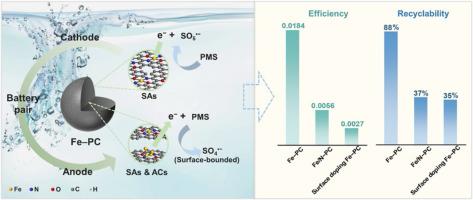Collaborative Catalysis of Single Atoms and Atomic Clusters as Dual Sites for Confined Peroxymonosulfate Activation to Coordinate Radical and Singlet Oxygen Pathways
IF 12.4
1区 环境科学与生态学
Q1 ENGINEERING, ENVIRONMENTAL
引用次数: 0
Abstract
Single-atom catalysts have attracted tremendous research interest in advanced oxidation water treatment, while their efficiency and recyclability were restricted by speciation. Deliberate manipulation of single-atom (SAs) accumulation and distribution to tune the catalyst efficiency and route constitutes an area of great interest but a challenging pursuit. Here, we developed a series of novel spherical porous carbon materials from biomass waste with a three-dimensional distribution of Fe. Fe SAs and atomic clusters (ACs) are simultaneously formed in catalysts, and their distribution from the outer surface to the inner core varies with pyrrolic N content. The cooperation of SAs and ACs serves as a pair of redox sites linked with graphitic carbon to coordinate the electron circulation with peroxymonosulfate (PMS), generating radical and singlet oxygen for antibiotic degradation. The confined environment and the cooperation of dual sites perpendicular to the carbon plane were first reported, which enhanced the generation of reactive species. These advantages afforded efficient degradation (up to 229% improved in kinetics and 133% improved in degradation) with heightened recyclability (up to 150% improved) compared to surface-doped SAs or ACs-dominated catalyst. Furthermore, this approach achieved efficient utilization of atomic metal sites compared to previously documented metal-based ADCs. This study reveals the synergy of SAs and ACs in a confined environment for cyclic electron transfer and inspires a new version for designing atomically dispersed Fe within the 3D structure for advanced water decontamination.

单原子和原子团簇作为限制过氧单硫酸盐活化的双位点协同催化协调自由基和单重态氧途径
单原子催化剂在深度氧化水处理中引起了广泛的研究兴趣,但其效率和可回收性受到形态的限制。有意操纵单原子(SAs)的积累和分布来调整催化剂的效率和路线是一个非常有趣的领域,但也是一个具有挑战性的追求。在此,我们从生物质废弃物中开发了一系列具有三维铁分布的新型球形多孔碳材料。Fe - sa和原子团簇(ACs)在催化剂中同时形成,它们从外表面到内核的分布随硝基氮含量的变化而变化。sa和ACs作为一对氧化还原位点与石墨碳连接,协调与过氧单硫酸根(PMS)的电子循环,产生自由基和单线态氧用于抗生素降解。首次报道了垂直于碳平面的双位点的协同作用和受限环境,促进了反应物质的生成。与表面掺杂的SAs或acs为主的催化剂相比,这些优势提供了有效的降解(动力学提高229%,降解提高133%)和更高的可回收性(提高150%)。此外,与先前记录的金属基adc相比,该方法实现了原子金属位点的有效利用。这项研究揭示了sa和ACs在循环电子转移的受限环境中的协同作用,并激发了在三维结构中设计原子分散Fe的新版本,用于高级水净化。
本文章由计算机程序翻译,如有差异,请以英文原文为准。
求助全文
约1分钟内获得全文
求助全文
来源期刊

Water Research
环境科学-工程:环境
CiteScore
20.80
自引率
9.40%
发文量
1307
审稿时长
38 days
期刊介绍:
Water Research, along with its open access companion journal Water Research X, serves as a platform for publishing original research papers covering various aspects of the science and technology related to the anthropogenic water cycle, water quality, and its management worldwide. The audience targeted by the journal comprises biologists, chemical engineers, chemists, civil engineers, environmental engineers, limnologists, and microbiologists. The scope of the journal include:
•Treatment processes for water and wastewaters (municipal, agricultural, industrial, and on-site treatment), including resource recovery and residuals management;
•Urban hydrology including sewer systems, stormwater management, and green infrastructure;
•Drinking water treatment and distribution;
•Potable and non-potable water reuse;
•Sanitation, public health, and risk assessment;
•Anaerobic digestion, solid and hazardous waste management, including source characterization and the effects and control of leachates and gaseous emissions;
•Contaminants (chemical, microbial, anthropogenic particles such as nanoparticles or microplastics) and related water quality sensing, monitoring, fate, and assessment;
•Anthropogenic impacts on inland, tidal, coastal and urban waters, focusing on surface and ground waters, and point and non-point sources of pollution;
•Environmental restoration, linked to surface water, groundwater and groundwater remediation;
•Analysis of the interfaces between sediments and water, and between water and atmosphere, focusing specifically on anthropogenic impacts;
•Mathematical modelling, systems analysis, machine learning, and beneficial use of big data related to the anthropogenic water cycle;
•Socio-economic, policy, and regulations studies.
 求助内容:
求助内容: 应助结果提醒方式:
应助结果提醒方式:


